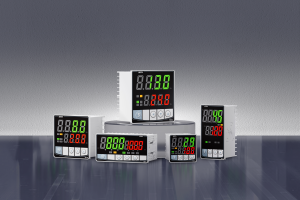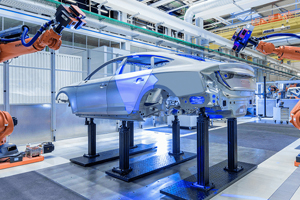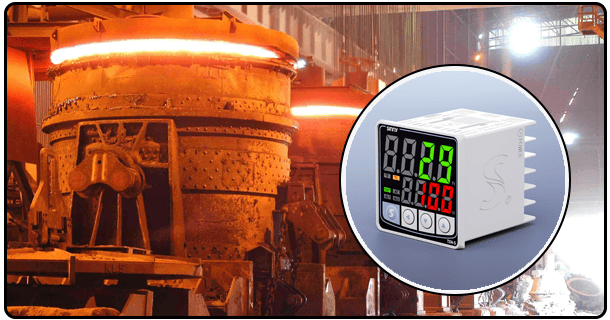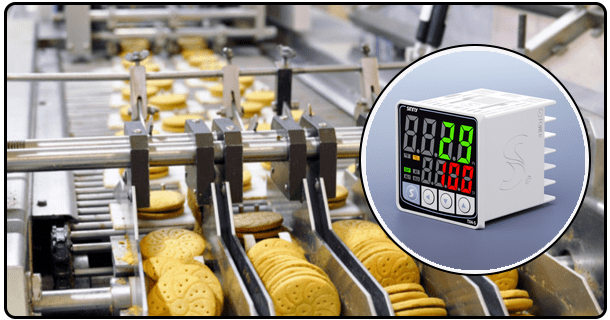Understanding temperature controllers with PID: An Expert's Guide to Process Control Optimization
Learn about the components and uses of temperature controllers that use PID. Learn about
1. Parts of the Temperature Control with PID
PID is a temperature control system that uses several components. These interconnected parts work together to provide optimum performance. To understand how the system works, it is important to know each component.
2. Controller Unit
It is the central brain of a temperature control system. The controller unit receives temperature data from the sensors, uses the PID algorithm to process this information, then generates a signal for the actuator. It can either be a hardware controller or software running on a computer or microcontroller.
The controller's hardware components include, for example, a microprocessor or microcontroller that performs PID calculations. Other components may also be included, such as input/output modules (I/O), which receive sensor signals and send actuator commands. Memory is used to store programs and data. The controller's intelligence is based on software algorithms. PID tuning, involving the setting of the gains in proportional integral and derivative terms is an important software feature. Software is often a feature of modern controllers that makes it easy to configure, tune, and monitor the process.
Actuator is responsible for implementing control actions determined by controller. The actuator translates the electrical signals from the controller into physical effects, like heating or cooling to get the temperature measured closer to desired setpoint. The actuator type used is determined by the application, and also the control process.
This lowers the temperature. To enhance heat transfer and maintain uniform temperature, fans circulate fluids or air. Valve control fluid flow, like coolant, heating medium or both, in order to regulate the rate of heat exchange. It is important that the actuator and controller are seamlessly integrated to ensure the correct translation of the control signals into physical actions. It is important to match the actuator with system needs, such as power consumption, reaction time and physical limitations.
3. Understanding PID Control
Understanding the functions of PID controllers is crucial to understanding how they achieve this.
Proportional Control
It is also the simplest of all three terms. The control output is calculated based on current error. This difference between desired setpoint and measured process temperature. This error directly affects the output signal. The larger the error is, the greater the output control, and vice-versa.
This is the mathematical expression of proportionality:
P = Kp * (e)
where:
The proportional output is P.
The proportional gain (Kp) is a tuning factor that controls the response of the control to an error.
The error is calculated by dividing the measured temperature (setpoint) by time t.
A proportional gain, or Kp for short, is a key factor in the response of a system. High Kp values result in more aggressive controls, which may lead to a faster response time but also an increased risk of oscillations and overshoot. Low Kp values result in more slow response. This may lead to better stability, but also slower convergence towards the setpoint.
It is a term that takes into account the cumulative effect of previous errors. The integral term integrates error over time and compensates for errors that are not eliminated by the proportional terms alone. Integral control outputs are proportional to integral of error for a specified time interval.
This is the mathematical expression of integral:
I = Ki* e(t).
where:
The integral output is I.
The integral gain is another tuning parameter which determines how fast the integral terms accumulate.
The integral error is e(t).
Integral terms help to reduce steady state error by ensuring the temperature of the process reaches its setpoint even when the proportional term cannot. Nevertheless, an excessive amount of integral action may lead to oscillations or instability, particularly at high integral gains. The integral gain (Ki), like the proportional terms, needs to be tuned carefully to maintain system stability while eliminating steady-state errors.
Derivative Control
It predicts errors in the future based on how fast the error is changing. The derivative term calculates how fast the error changes and then uses that information to produce a control input which helps dampen oscillations, and improves system stability. The derivative output of a control system is proportional the the derivative error in relation to time.
This is the mathematical expression of a derivative term:
D = Kd * de(t)/dt
where:
The derivative output is D.
Kd, or derivative gain is a tuning factor that controls the response of the control to changes in the error rate.
The derivative de(t/dt) of an error in relation to time represents the rate at which the error changes.
It is especially useful for predicting system behaviour and preventing oscillations and overshoot. The derivative term acts as a stabilizing force that helps to improve the response of a system. The derivative term is sensitive to the noise that can occur in sensor measurements. This can cause erratic behavior. To maximize the derivative control benefits, it is important to carefully select the derivative gain (Kd).
It is important to tune the three PID gains, Kp, Kd, in order for a PID control system to be effective. The process of PID tuning involves determining optimal gains for a desired control performance. This includes minimising overshoot and settling times, as well as steady state error. For PID tuning there are many methods, from automated algorithms to manual techniques.
Ziegler Nichols Method is one of the most popular manual tuning methods. The method involves two steps. First, determine the ultimate gain of the process (Ku), and then the ultimate cycle duration (Tu). This is done by increasing the gain proportionally until the system begins to oscillate at a constant frequency. Then, you can use the Ku and Tu values to determine the Kp, Kd, and Ki values based on the empirical formulas. The Ziegler Nichols method, while simple and a great starting point, may not work for every system and requires additional fine tuning.
Software-based tuning techniques, on the other hand, offer greater flexibility and are more efficient for complex processes. They use advanced algorithms such as adaptive tuning and model-based optimization to analyze process dynamics. This allows them to automatically calculate the best PID gain. The software-based method is particularly useful in situations where manual tuning would be difficult, time-consuming or the dynamics of a process might change over time.
Regardless of which method is used, tuning PIDs requires observation and adjustments. To ensure the performance desired, the chosen gains must be verified in the real system. Many advanced PID controllers provide tools to monitor the control process and visualise the system response. They also facilitate the tuning process.
Improved safety: The PID controller helps to reduce safety risks by making sure that the processes run within safe temperatures limits.
Improved efficiency: Controlling temperature at a constant level optimizes the efficiency of processes, while reducing waste and energy consumption.
Less downtime: The PID controllers reduce downtime through the prevention of equipment damage, and by maintaining a consistent operation.
HVAC systems play a vital role in maintaining a healthy and comfortable indoor environment. These systems rely on temperature controllers that use PID algorithms to maintain the desired temperature.
The role of temperature controls in HVAC systems includes:
Heating PID Controllers control the output of heaters such as boilers and furnaces to achieve the desired temperature in the room.
Cooling : The PID controllers control the cooling system, e.g. air conditioners, chillers, etc., in order to keep the indoor temperature at the set point.
Humidity Control: Certain PID controllers can also regulate humidity levels and contribute to the overall quality of indoor air.
Savings on energy and costs:
4.The importance of temperature control for experiments is:
The following are some of the advantages to using PID controllers for research:
Improved accuracy: The PID controllers are highly accurate and ensure that the experiments conducted in a reproducible environment.
Increased reliability: The PID controllers minimize the risks of temperature fluctuations, which could affect experimental results.
Flexibility PID Controllers can easily be configured to meet specific temperature control needs of different experiments.
5.Increased stability and accuracy:
PID controllers are known for their high accuracy and stability. Combining proportional, integrated, and derivative controls allows precise control of the process variables, while ensuring the temperature stays close to desired setpoints even when there are disturbances.
6. Overshoot time and settlement times reduced:
The PID controllers reduce the overshoot time and settle-down time by a significant amount compared with simpler methods of control. Overshoot is how far the process variables exceed the setpoint, before they settle down. Settling time refers to time taken for the variable to achieve and stay within the specified tolerance range around the setpoint. It is possible to reduce overshoot by carefully tuning PID gains. This will result in faster settling time and more responsive and efficient control.
7. Adaptability for different control scenarios
The PID controllers can adapt to a variety of scenarios, ranging from the simple to the complex. They are flexible and can be used for a variety of applications. This includes those that have linear dynamics or nonlinear processes.
The complexity of tuning and implementation
The complexity of tuning and implementing PID controllers can be a challenge. A good understanding of process dynamics is required to properly tune the PID controller. It may involve trial and error adjustments, and require special knowledge or experience. Implementing a PID can also be complicated, as it requires the integration of multiple hardware and software elements.
8. Sensor drift and noise are possible.
Temperature sensors are a major factor in the accuracy of PID controllers. Sensor drift can cause inaccurate temperature measurements and poor performance of the controller. Noise in the sensor's signal can affect controller performance as well. This noise can come from electrical interference, mechanical vibrations or other factors.























